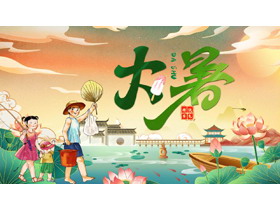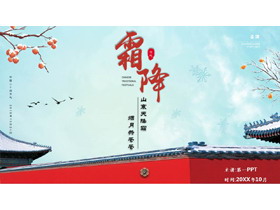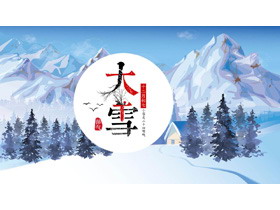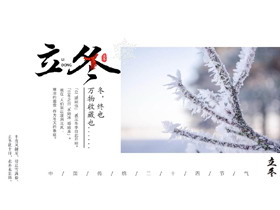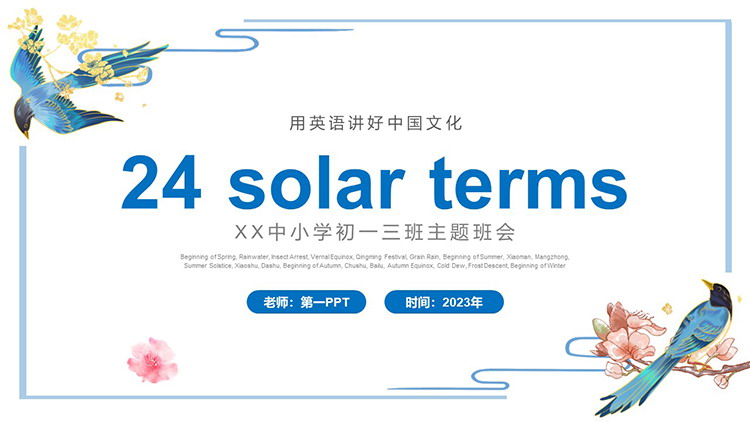

这是一套这是一套花鸟背景的二十四节气英文介绍PPT模板,共33页;
PPT模板封面,使用了蓝色小鸟、粉色花朵背景图片。中间填写二十四节气英文介绍主题班会PPT标题。界面风格清新唯美。
PowerPoint模板内容页,由31张节气介绍动态幻灯片,搭配PPT文字排版组成。另外使用了红色西瓜插图、飞鸟插图、绿色青蛙插图等,节气相关动植物、风俗习惯插图装饰。
二十四节气英文介绍主题班会PPT内容简介:
春Spring
春,汉语常用字,读作chūn,最早见于甲骨文,其本义是草木的种子生根发芽,后延伸至以“春”作为一年四季的第一季名。《说文解字》认为“春,推也”,也即有“春阳抚照,万物滋荣”之意,故又可延伸至生机勃勃,充满活力等意。
Beginning of Spring
立春
At the beginning of spring, Dou points to the northeast. The yellow longitude of the sun is 315 degrees. It is the first of the twenty four solar terms.
Its meaning is to begin to enter spring, "When the sun and the insects rise, all things are in spring." After the beginning of spring, everything recovers and becomes vibrant, and the four seasons of the year begin from then on.
Rain Water
雨水
Rain water: Dou zhi ren. The yellow longitude of the sun is 330 degrees. At this time, the spring breeze blows all over, the ice and snow melt, the air is moist, and the rain increases, so it is called rain.
People often say, "As spring warms up, rain is busy delivering fertilizer.".
The Waking of Insects
惊蛰
Waking of Insects : Dou zhi ding. The yellow longitude of the sun is 345 degrees. This solar term indicates that after the "Beginning of Spring", the weather turns warmer, and spring thunder begins to sound. Various hibernating animals that hibernate in the soil will wake up and begin to move, so it is called Waking of Insects . During this period, insects that hibernate also begin to hatch.
Some regions of China have entered the spring ploughing season. As the saying goes, "After a sting, it is warm, and the old toad sings a mountain song.".
"When a stinging insect plows the soil, the spring equinox brings the earth's atmosphere through.". "Before the thunder strikes, the heavy rain seems like a dragon.".
Spring Equinox
春分
Spring Equinox: Dou zhi ren. The yellow longitude of the sun is 0 °. The sun is above the equator on the vernal equinox. This is the midpoint of the 90 days of spring, when the days and nights in the northern and southern hemispheres are equal, so it is called the vernal equinox. After this day, the direct sunlight position will move northward, and the northern hemisphere has long days and short nights. So the vernal equinox is the beginning of spring in the northern hemisphere.
The overwintering crops in most regions of China have entered the spring growth stage.
Local agricultural proverbs include: "The spring equinox comes first, and rice is exchanged for money." (Guangdong), "The spring equinox brings rain, and the summer equinox brings fire." (Sichuan), "The spring equinox brings rain, and families are busy planting melon beans before transplanting seedlings." (Hubei), "The spring equinox brings vegetables, and the summer brings melons." (Hunan), "The spring equinox brings hemp beans, and the autumn brings wheat and garlic." (Anhui).
Pure Brightness
清明
Pure Brightness: Dou zhi ding. The yellow longitude of the sun is 15 °. At this time, the climate is cool and warm, with grass and trees beginning to sprout, and everything begins to grow. Farmers are busy cultivating and planting in spring.
Once upon a time, on the Tomb Sweeping Day, some families inserted willow sticks at the door, and also went on outings in the suburbs to worship and sweep the tombs. This is an ancient custom.
Grain Rain
谷雨
Grain Rain: Dou zhi gui. The yellow longitude of the sun is 30 degrees. "Rain produces grains. As rain nourishes the earth and the grains grow, grain rain means" rain produces hundreds of grains. ". As the saying goes, "Before and after the grain rain, plant melons and beans.".
夏
Summer
夏,汉语一级字,读作xià或jiǎ,最早见于甲骨文,其本义是雄武的中国人或中国人(两处的“中国”都特指“中原一带”),即《说文解字》所谓的“中国之人也”,后假借指一年四季之中的第二季。
Beginning of Summer
立夏
Beginning of Summer: Dou zhi refers to the southeast. The yellow longitude of the sun is 45 degrees. It is the beginning of summer, and as it enters summer, everything flourishes.
It is customary to regard the beginning of summer as the most important solar term for a significant increase in temperature, imminent summer heat, increased thunderstorms, and the growth of crops in the peak season.
Lesser Fullness of Grain
小满
Lesser Fullness of Grain: Nail fighting. The yellow longitude of the sun is 60 °. Starting from Lesser Fullness of Grain, summer crops such as barley and winter wheat have already borne fruit and full grains, but they have not yet matured, so they are called Lesser Fullness of Grain.
Grain in Beard
芒种
Grain in Ear: The Bei dou points to itself. The yellow longitude of the sun is 75 degrees. This is the best time to plant grain crops with awns, such as late grain, millet, and millet. After this time, it will not be easy to mature if you plant awns and crops again. At the same time, "awn" refers to awned crops such as wheat, barley, and "seed" refers to seeds.
Grain in the ear indicates that wheat and other crops with grain in the ear are mature. Before and after awning, in the middle and lower reaches of the Yangtze River in central China, rainfall increased and temperatures increased, leading to the continuous rainy plum rain season. The air was very humid, the weather was unusually sultry, and various appliances and clothing were prone to mold. Therefore, in the middle and lower reaches of the Yangtze River in China, it was also called "moldy rain".
Summer Solstice
夏至
Summer Solstice: The Beidou points to B. The yellow longitude of the sun is 90 degrees. When the sun is at the "summer solstice point" at 90 ° of the yellow longitude, the sunlight almost directly shines over the Tropic of Cancer, with the highest sun in the northern hemisphere at noon. This day is the longest day and shortest night in the Northern Hemisphere. Starting from this day, we enter the hot season , at which time everything in the world grows most vigorously.
Therefore, in ancient times, this day was also called the solar solstice, which means the day when the sun moves to the northernmost point. After the summer solstice, the sun gradually moves southward, shortening the days and lengthening the nights in the northern hemisphere.
Lesser Heat
小暑
Lesser Heat: Dou zhi Xin. The yellow longitude of the sun is 105 degrees. The weather is already very hot, but it is not yet at its hottest time, so it is called Lesser Heat. At this point, it is already around the initial ambush.
Greater Heat
大暑
Greater Heat : Dou Zhi Bing. The yellow longitude of the sun is 120 °. Heat stroke is the hottest solar term of the year. Around the second hour of duty, high temperatures of 40 ℃ often occur in many parts of the Yangtze River basin. Do a good job in heatstroke prevention and cooling. "This solar term has a lot of rain. In the proverb" Small and severe heatstrokes drown rats ", it is necessary to pay attention to flood prevention and waterlogging prevention.".
秋
Autumn
秋(拼音:qiū)为汉语一级通用规范汉字(常用字)。此字始见于商代甲骨文。秋的古字形像蟋蟀或蝗虫,甲骨文中假借为“秋季”。从天文历法上说,秋是一年四季中夏后冬前的季节。
Beginning of Summer
立秋
Beginning of Autumn : The Bei dou points to the southwest.
The yellow longitude of the sun is 135 degrees. From this day on, autumn begins, with a clear sky, bright moon, and clear wind. After that, the temperature gradually decreased from the hottest.
End of Heat
处暑
End of Heat : Dou zhi wu. The yellow longitude of the sun is 150 °. By this time, the summer heat had come to an end. The heat is about to dissipate. It is a turning point in temperature decline. It is a symbol of the cooling of the climate, indicating the end of the summer.
White Dew
白露
Dew is a drop of water formed by condensation of water vapor on the ground or near ground objects due to a decrease in temperature. Therefore, white dew actually indicates that the weather has turned cooler. In the climate of the 24 solar terms in the basin of our province, White Dew has the obvious characteristics of rapid temperature drop, continuous rain start, and sudden decrease in sunlight, which deeply reflects the seasonal transition from summer to autumn. During the perennial period of white dew in the basin, the average temperature is about 3 ℃ lower than that in summer, and the average temperature in most regions (5 days) has successively dropped to below 22 ℃.
Autumn Equinox
秋分
Is a solar term that represents seasonal changes. On the autumnal equinox, the sun is located at 180 degrees in the yellow longitude, with sunlight almost directly reaching the equator, and the day and night are almost equal in length. At this time, the temperature in the Sichuan Basin generally dropped below 22 ℃,
entering a cool autumn. "An autumn rain and a cold spell.". A stream of cold air descending from the south meets the gradually decaying warm and humid air, producing rain and falling temperatures. In the northern part of the Western Sichuan Plateau, the daily minimum air temperature has dropped below 0 ℃, and a magnificent snow scene can already be seen, with the sky fluttering and the earth covered in silver.
Cold Dew
寒露
In ancient times, dew was used as a sign that the weather turned cold. "The Mid Autumn White Dew solar term is" dewy and white ", and by the time of the cold dew in the mid autumn, it is already" dewy and cold, and will condense "into frost.". At this time, temperatures across Sichuan Province continued to decline. The daily average temperature in the basin is usually less than 20 ℃. Even in the coastal areas of the Yangtze River, it is difficult for the mercury column to rise above 30 ℃, while the minimum temperature can fall below 10 ℃.
冬
Winter
冬(拼音:dōng)是汉语通用规范一级汉字(常用字)。此字一般认为始见于商代甲骨文,其古字形像绳子两端有结的样子,意为终结、终端,是“终”的初文。冬季是一年中最后一个季节,故“冬”又指冬季。
Beginning of Winter
立冬
"stand , Start of establishment" means that winter begins from here. "On the day of the beginning of winter, when winter begins, the water begins to ice, and the ground begins to freeze.". People often use the cold north wind, cold frost and snow as a symbol of winter. The basins of our province are also sparsely covered with frost and snow, so in climatology, it is not fixed to use the day of "the beginning of winter" as the beginning of winter in various regions, but to divide the seasons by temperature, that is, when the average temperature of the season (5 days) is lower than 10 ℃, it is winter, which is more suitable for the phenological landscape at that time.
Lesser Snow
小雪
Light snow indicates the starting time and extent of snowfall. Snow is a product of cold weather. During the light snow season, northern Sichuan Basin began to enter winter. "The lotus has disappeared without a rain cover, and the chrysanthemum remains with proud frost branches." It has taken on a scene of early winter. Due to the Qin ling Mountains and Da ba Mountains in the north, which block the invasion of cold air and reduce the severity of the cold wave, the basin is significantly "warm in winter". The number of snowfall days throughout the year is mostly less than 5 days, much less than in the middle and lower reaches of the Yangtze River at the same latitude.
Greater Snow
大雪
"Greater snow" indicates that it is now beginning to snow heavily. The winter climate in the Sichuan Basin is mild with little rain and snow. The average temperature is about 2 ℃ to 4 ℃ higher than that in the middle and lower reaches of the Yangtze River, and the rainfall accounts for only about 5% of the entire year. Occasional snowfall, mostly in January and February; Snow on the ground is rarely seen once in three or five years. If you can witness the land covered with white snow and green trees decorated with silver and jade, it is often a lifetime unforgettable fun.
Greater Snow
冬至
The winter solstice is a astronomical division of the solar term, known as the "short day" or "short solstice" in ancient times. On the winter solstice, the sun is located at 270 degrees in the yellow longitude, and the sun is almost directly shining on the Tropic of Cancer. It is the shortest day of the year in the Northern Hemisphere. There are no more than 10 hours between sunrise and sunrise in various parts of Sichuan Province. After the winter solstice, as the Earth moves in its orbit around the sun, the direct sunlight zone gradually moves northward, increasing the number of days and shortening the length of nights in the northern hemisphere.
Lesser Cold
小寒
Cold means cold, and a slight cold indicates the degree of cold. As the saying goes, "Cold is at 39.". The "March 9th" period is mostly from January 9th to 17th, which is also within the small cold solar term. However, this is only a general rule, and a few years of severe cold may also be colder than a small one. In the winter of 1975, when people still remember it, the coldest solar term was actually heavy snow!
Greater Cold
大寒
In severe cold seasons, appropriate low temperatures are required during a certain growth period. Wheat and rape with strong winterness require lower temperatures during the vernalization stage, otherwise they cannot grow and develop normally.
...
本模板适合用于制作二十四节气介绍主题班会PowerPoint。.PPTX格式;






